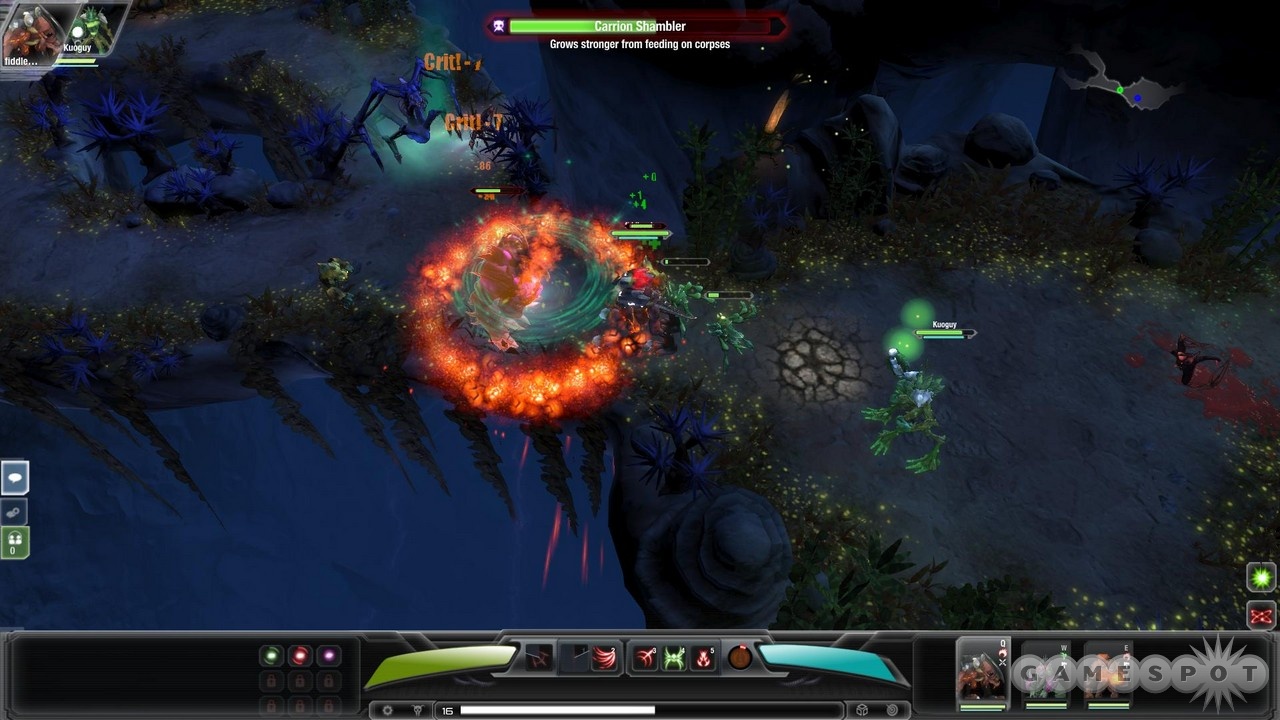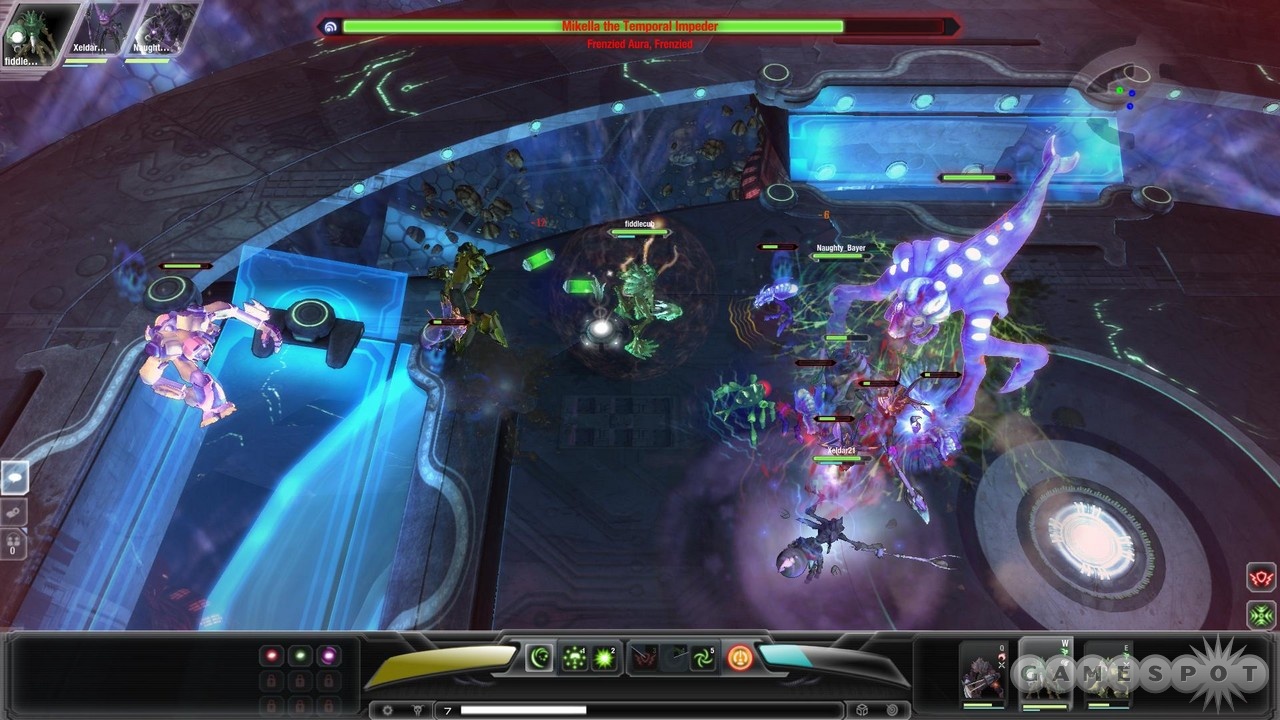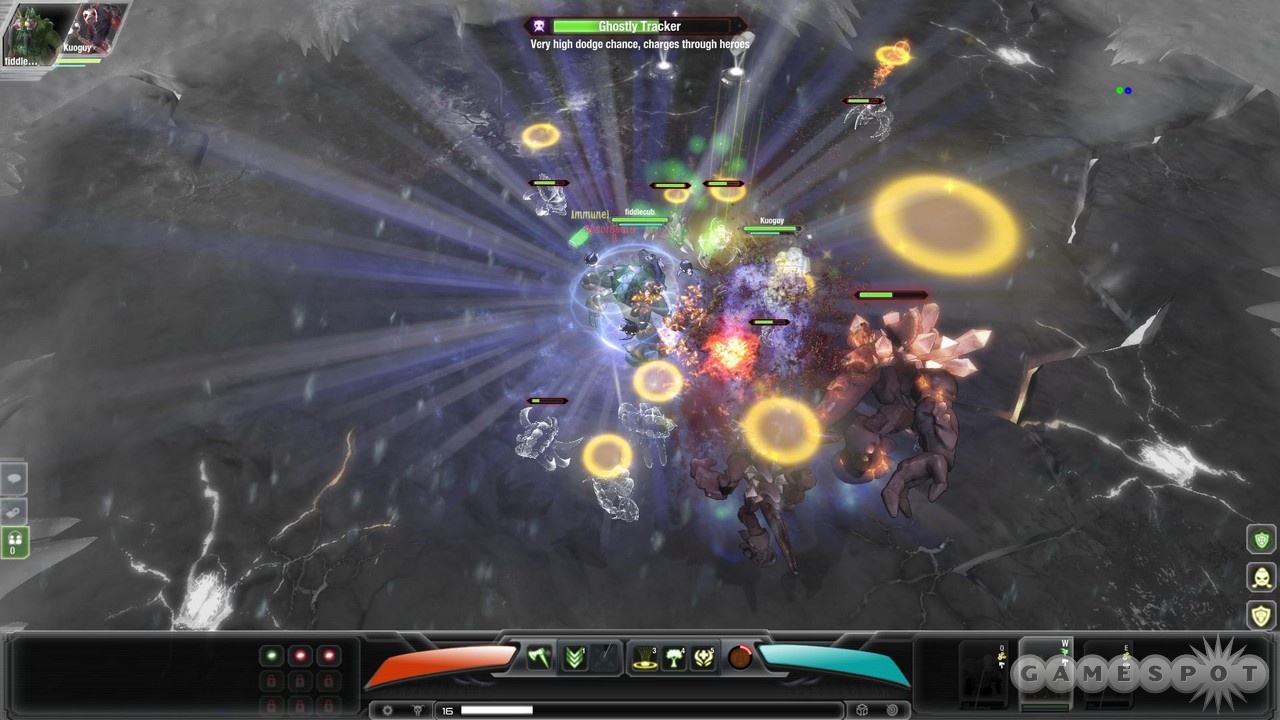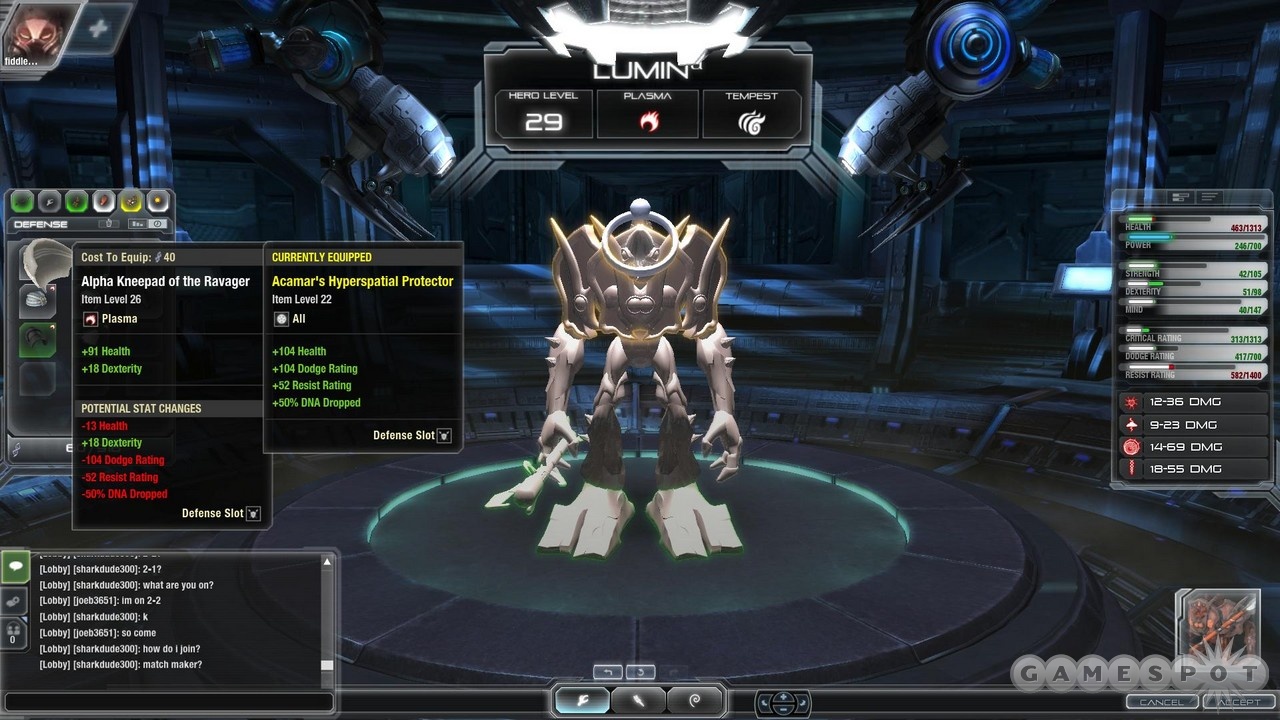You'd be forgiven if you assumed Darkspore might be similar to 2008's Spore; after all, the titles are similar, and both games were created by the same developer. Well, let go of any preconceptions: this spin-off may have some elements in common with the game that spawned it, but it is structurally quite different. It's also rather good. Darkspore is an online-only role-playing game in which you and up to three buddies (or strangers) slice and dice your way through factory corridors and forest pathways en route to an end boss. Your goal: collect as much awesome loot as you can. And you'll need all you can get, for as you level up, you gain access to more and more heroes and group them into squads of three creatures each. This "catch 'em all" mechanic is one of Darkspore's main draws, though there are a few other twists on the traditional action RPG formula that keep it from feeling like a simple space-age Diablo clone.
That isn't to say that Darkspore feels totally fresh, however. There's too little context for all this hacking and slashing: it's all grinding for levels and loot, with little sense of purpose. That might sound like a damning flaw, but some hours in, the game hits its stride, throwing greater challenges at you on the battlefield and balancing the dungeon crawling with the satisfaction of maintaining the look and equipment of up to 100 different heroes. These elements don't fully compensate for the missed opportunities, but they're enough to make for dozens upon dozens of entertaining hours in front of your monitor.
Make sure to note the "online only" bit. Though you can play on your own, you must be online and signed into the game in order to play. Once signed in, you enter a game hub and a chat lobby, where you can find other players to group up with while futzing around with your inventory. The first time you sign in, a tutorial gets you quickly up to speed, putting you in control of a nimble little scamp called Blitz. Blitz, like all of Darkspore's heroes, is a creature that would have been right at home in Spore. Some of the game's heroes look like insects; others, like robots; and still others, like the monsters your childhood self imagined might be hiding under your bed or in your closet. In any case, Blitz is easy to get a handle on: you click to move, you click to attack, and you press a numeral key to perform special attacks. In Blitz's case, he can teleport forward for a quick, stunning attack; deliver a flurry of slashes with his claws; and surround himself with electrical globes that zap nearby enemies.

Blitz is only the beginning. As you play, you gain access to more heroes that you can take into battle. There are a hundred in total, though this number is a bit misleading: there are actually four variants of 25 heroes, with each variant having slightly different special abilities. For example, one variant of Sage has the "enrage" ability, while another replaces it with a root skill called "virulent vines." It'll be quite a while before you get to play with all of them, however, because you get to choose a new hero only when you reach certain level milestones. In turn, you group these heroes into squads--three heroes to a squad, and three squads in total. Before heading into a level, you choose which squad you wish to take with you, though you have to be mindful of your squad's strengths and weaknesses. Each hero is classified not just by class, but also by a genesis type. (Think of genesis types as the elemental affiliations you might see in other RPGs, though instead of fire, ice, and earth, you get types like cyber, necro, and plasma.) Enemies are similarly classified and do double damage to heroes of the same genesis.
The most obvious way that Darkspore sets itself apart on the battlefield is in how it implements squads. While you control only one hero at a time, you can switch between them in dungeons. Each hero has three individual active abilities available, as well as a squad ability accessible by the other two squad members. This means a hero has six skills in total at one time: four innate, and two shared by other heroes. This all sounds mighty complex, but for quite a few hours, you may be struck at how simple the combat is in spite of all these layers. Whether you play as a melee or a ranged hero, the combat is that of most such games: you click and attack. You can do so on your own, but Darkspore is a cooperative experience. Therefore, it's best to hook up with friends or let the matchmaking join you with others and drop you into the next dungeon in your progression (or one you have already completed).

Whether you're alone or with three others, the early hours are entertaining, but hardly noteworthy. Levels are a series of corridors in alien forests, frigid tundras, and rocky cliffs, separated by glowing teleporters that zip you to the next location. A droning computer voice fills you in on some backstory prior to many missions, and even during them, but counting these yawn-inducing updates as narrative would be giving them far too much credit. There is talk of genetic manipulation and numerous mentions of "the Darkspore threat," but you don't experience a story: you are only told of one. Action RPGs aren't traditionally story-driven ventures, but few give this little context. There are no quests and no non-player characters to chat with. Your objectives are always this: kill marauding aliens, find the hidden loot caches, and defeat the final boss. It's bare-bones even by genre standards, and the lack of challenge in the early going reinforces the bareness and leads to monotony.
In time, however, Darkspore fills in these gaps and shows what it's capable of--and to be fair, even the early hours are fun in the way most good loot-driven games are fun. It helps that Darkspore has a spacey, New Age vibe that sets it apart from similar games. An early level featuring glowing walkways hovering over asteroids and space wreckage is striking, as is a later one in which you encounter a lush green oasis where you would least expect it. Your team's exaggerated monstrosities are a natural fit in this universe where biology and technology are impossible to separate. The soundtrack's electronic murmurs and deep kettledrums are equally fitting. Against these serene backdrops, you unleash deadly cones of flame and summon glimmering trees of healing, and defeating aliens frequently results in a geyser of red and purple goo. Darkspore doesn't push a lot of polygons, and there are too many same-ish mountain passes and bland green meadows for it to reach artistic greatness. But it looks attractive and runs well even on modest PCs.
Once you reach the later levels of the campaign in your first pass-through, however, two important things happen: battles require more teamwork and squad tactics, and hero customization begins to show some spark. Between levels, you equip your heroes with the spoils of battle, using Spore's creature editor to slot in new feet and hands and attach tentacles and pauldrons on your creatures' bodies in any way you please. If you played Spore, this pared-down editor may serve only to remind you of the earlier game's extraordinary creature creation, with which you could create outlandish beasts from scratch. In Darkspore, your heroes' basic forms are static, so you aren't playing as an omniscient creator, but more of a sci-fi stylist. When your heroes are low in number and you possess a modest inventory of equipment, you might wish the game took this aspect even further: in the first dozen hours or so, it feels as though you're just sticking random doodads on your lumbering fire ogre.
Once Darkspore reaches full speed, you gain more appreciation for the customization. You might be inclined to place those horns where you think horns should go--but why not stick them over the eyes instead and increase their size? Suddenly, your snarling demon of despair looks like he has upside-down funnels on his face, providing a nice contrast to the oversized webbed feet splaying underneath and the curved shield applied in such a way as to look like a jaunty mustache. In the early levels you might be struck by how your Arachna looks like everyone else's Arachna, but those similarities diminish with each visit to the editor. Certainly, Spore proved that this editor is capable of delivering more, but on its own terms, Darkspore's take on cosmetic embellishment still stands above its peers.
This equipment isn't just for show, however: it makes you stronger, more dexterous, and so on. The easy early going and constant stream of DNA (Darkspore's currency) may lead you to believe you don't need to give too much thought to what you equip or how you group your heroes. When Darkspore starts delivering the challenge, however, you start appreciating how the combat is evolving and how your squad composition relates to your success. Simple cannon fodder is replaced by beetles that split in two and giant robots emanating static laser beams that damage players who cross them. Gravity wells suck you toward them, and scurrying pests erupt plasma mines upon death that injure you if you make contact. The more people on your team, the tougher and more varied your enemies are, and the more you need to make use of all of your powers. Your rooting ability may not get much use when it's just a few of you, but when a horde of ghostly scorpion-things is descending on you, the team will appreciate the assistance.

Once you beat the challenging and fun final boss in your first pass of the campaign, things get even tougher--and thus more rewarding. And if you want even greater rewards, you can chain battles together. After each level, you have an option to either collect some end-level loot or enter the next sequential level and sacrifice that loot for a chance at even better stuff. Successfully chaining three or four challenging levels is one of Darkspore's greatest pleasures, and the rising challenge culminates in nail-biting boss fights. The fun is dampened only by a few rare but odd quirks, such as how a unit might not respond to your mouse clicks. Other annoyances crop up outside of battle. The overzealous profanity filter can turn innocent sentences into hysterical collections of asterisks, and as fulfilling as customization can be, the inventory and editing interfaces are a handful once you're drowning in loot and heroes.
If you'd like to further explore your squads' tactical possibilities, you can participate in player-versus-player battles. These are limited to one-versus-one and two-versus-two matches--a disappointing constraint. It's easy to imagine how large-scale battles could have capitalized on the game's intriguing squad flexibility. Nevertheless, Darkspore's PVP is a different creature than its cooperative play and requires a shift in tactics. You shouldn't just bash on your opponent unless you prefer the victim role, because you'll be slaughtered. Instead, you must carefully consider how your squads' abilities can be combined in useful ways. Roots, slows, and stuns all have important roles to play. Need to buy yourself some healing time? Use Maldri to temporarily suspend your competitor in the air. Need to put space between you and your opponent so you might unleash a missile barrage? Sage's root will do the trick. Even once you get a handle on PVP, it's still not clear how balanced these matches are. You might crush your competitor mercilessly with little effort, or get a harsh schooling even when applying effective strategies. Therefore, PVP seems a likely destination only for the Darkspore elite, while most will delight in the co-op's more consistent joys.

At first, it's easy to dismiss Darkspore as an experiment not taken far enough. After all, its basic structure is a series of stand-alone dungeons, which are stitched together by a simple online lobby, a pared-down version of a capable creature editor, and a wholly uninspired attempt to weave some fiction around it all. Yet what seem like missed opportunities in the early going blossom later, when the game fleshes out the relationship between your squad and the events on the battlefield. Eventually, Darkspore finds a good balance between time spent in battle and time spent within the editor, rewarding you for proper preparation and battlefield awareness. The chance to take on a greater challenge for greater reward further fuels your desire to push ahead, as does the promise of new, strange creatures to deploy.



